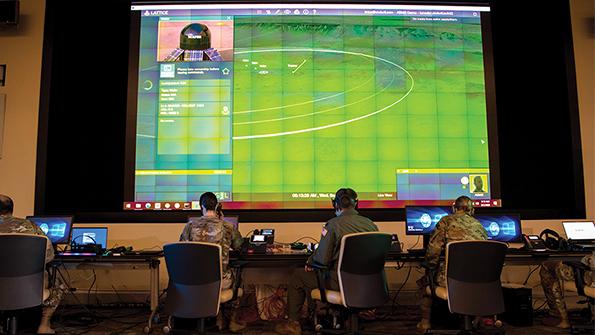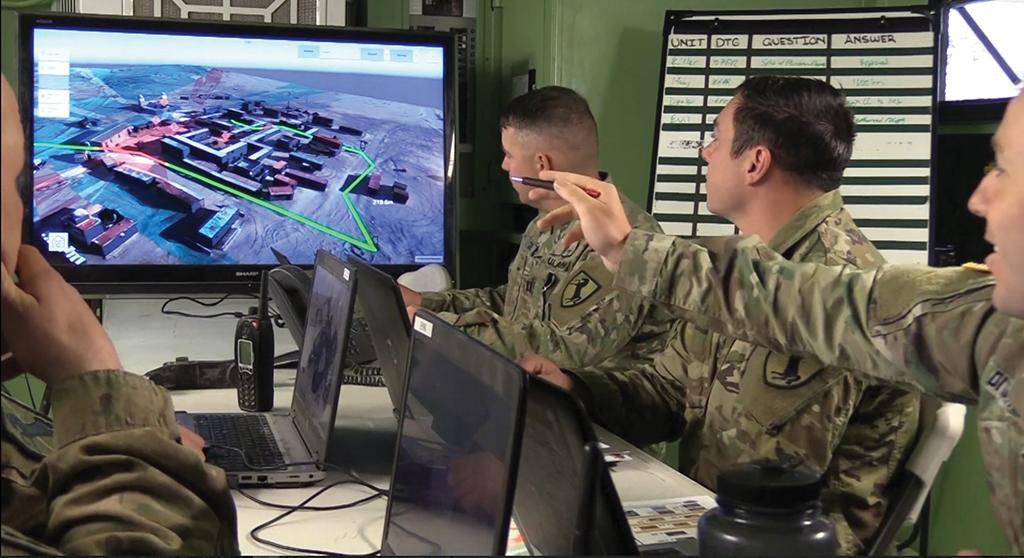
What seemed for so long like an eternally distant vision of a disparate military force seamlessly connected across a vast battlefield and enabled by a highly automated command-and-control infrastructure began making tangible progress in 2020.
In a September demonstration described as historic by Will Roper—the assistant Air Force secretary for acquisition, technology and logistics—airborne sensors fed targeting data to the Army’s mobile howitzers, which shot down a surrogate cruise-missile target with a BAE Systems hyper-velocity projectile (HVP).
That Onramp event highlighting the Air Force’s Advanced Battle Management System (ABMS) was followed up quickly in October by the Army’s first Project Convergence demonstration, which tried out artificial-intelligence algorithms that automatically paired newly discovered targets with the appropriate weapon systems, closing a complex decision-making loop in seconds instead of minutes, hours or even days.
- Army’s Project Convergence 21 invites Air Force and Navy
- Despite budget setbacks, Air Force Onramp events continue
A seemingly notable lack of any related public demonstrations by the Navy is misleading. A year before the very public ABMS Onramps and Project Convergence events, the secretive Navy Tactical Grid experiments involved Navy and Marine Corps units. Building on the 15-year-old Cooperative Engagement Capability (CEC)—perhaps the original multi-domain, albeit single-service, targeting system—the Navy Tactical Grid events will serve as the stepping stone for the Navy’s newly launched Project Overmatch demonstration series in 2021.
Behind the scenes, DARPA continues releasing new networking tools developed under the mostly public Mosaic concept. The agency’s scientists also are designing a new concept to “give an adversary pause” within the first hours of a war under the secretive Assault Breaker II program.
In every military branch and domain, more ambitious experiments and demonstrations are scheduled in 2021, with the common goal to finally replace the somewhat magical lightning bolts on so many PowerPoint slides of the past two decades with compatible communication systems.
All around the world, a confluence of operational necessity and technology advances is driving militaries to similar concepts. NATO’s Alliance Future Surveillance and Control studies are scheduled to begin in the second quarter of 2021, seeking to define a replacement for the Boeing E-3 Airborne Warning and Control System that follows the decentralized and highly auto-mated approach of the ABMS.

In some countries, the concept is already in service. At the beginning of 2020, Israeli defense industry officials outlined Rafael’s “Smart Trigger” system. Now demonstrated at the battalion level of the Israeli Defense Forces (IDF), the system is designed to eliminate targets within seconds. Software algorithms automatically pair identified targets and the most appropriate weapon systems. In combination with Israel Aerospace Industries’ Opal airborne networking system, the IDF already operates a multi-domain command-and-control system.
“If it didn’t exist in the world around us, you’d probably say it was impossible,” Roper said in a media roundtable discussion last January. Now, the challenge is expanding the Smart Trigger concept from the IDF’s focus on a single village to the U.S. military’s concentration on a theater of operations as large as the Pacific Ocean.
At stake is a capability that forms the core of the 2018 National Defense Strategy (NDS): harnessing the full might of the U.S. military’s often stovepiped resources to be prepared to fight a theoretical war with a numerically superior Chinese opponent and a strengthened Russian adversary by 2028.
In such a conflict, the Pentagon’s war planners hope to avoid a lengthy war of attrition by delivering a strategic fait accompli. By demonstrating the capability to unleash a widespread conventional attack that effectively disables thousands of far-flung Chinese or Russian military assets within hours or days, the goal would be to deter such a war.
To show it is not a bluff, the U.S. Defense Department must demonstrate a capacity for command and control at an unprecedented scale and speed. The task far exceeds the ability of the current targeting system, especially for targets lying tens of hundreds of miles beyond the front lines. The highly centralized, human-driven command-and-control apparatus on which the U.S. military has relied since the end of the Cold War lacks the capacity to support such operations. Enemies also have invested heavily to render the platforms at the heart of that system vulnerable to attack.
Thus, the Defense Department defined a concept originally known as multi-domain command and control (MDC2). As the concept has been embraced across the services, the abbreviation continues to change. To recognize the elevation of the concept from a service-driven proposal to a Joint Staff-directed vision two years ago, the MDC2 construct became known as Joint All-Domain Command and Control (JADC2). After the leaders of the Army and Air Force agreed to team up in September on an execution plan, the Pentagon changed the name again to Combined Joint All-Domain Command and Control (CJADC2).
The ABMS is the Air Force’s seemingly ever-evolving contribution to JADC2. The Air Force unveiled the ABMS in 2018 as a concept to rely on a distributed network of processors installed aboard manned and unmanned aircraft to replace the Northrop Grumman E-8C Joint Stars fleet. By January 2020, the Air Force reintroduced the ABMS as an architecture composed of more than 30 product lines that include a compatible array of radios, radars, apertures and cloud-based networking platforms.
To the frustration of some in Congress, Air Force leaders resist laying out the ABMS program as a traditional acquisition program, with a development period for a new technology that transitions into full-rate production only after achieving a set of predefined requirements established by a consensus within the Pentagon. To Roper, that method is an outdated legacy of an acquisition strategy rooted in hardware-driven technological advances. ABMS, by contrast, is expected to be driven by software development, with rapid and potentially unpredictable leaps in new capabilities, according to Air Force officials.
In anticipation of an accelerated development cycle, the Air Force launched a quarterly series of ABMS Onramp events in December 2019. Although held about four months late in early September due to the effects of the COVID-19 pandemic, Air Force officials heralded the second Onramp event as a key milestone. With about 60 different data sources feeding into a new, cloud-based processing system, a set of ABMS applications developed targeting solutions for BQM-167 target drones posing as cruise missiles. They were engaged by General Atomics Aeronautical Systems MQ-9s firing Raytheon AIM-9X missiles and HVPs launched from the Army’s M109 Paladin self-propelled howitzers.
Despite the apparent success of the event, many lawmakers remain unimpressed. Criticizing the Air Force’s lack of a detailed set of approved requirements, House and Senate appro-priators voted to substantially curtail funding for the ABMS program in fiscal 2021. Regardless, the Air Force still plans multiple ABMS Onramp events in 2021.
The Army staged Project Convergence in September as a multi-domain experiment but excluded other services. The Army’s experimental satellites, such as Kestrel Eye, teamed with airborne sensors that included Air-Launched Effects provided by the General Atomics Aeronautical Systems MQ-1C Gray Eagle. Those sensors fed imagery to the Army’s prototype for the Tactical Intelligence Targeting Access Node ground system, which used software algorithms to identify the targets without human assistance and select the “shooter.”
On Nov. 3, the Army’s Joint Modernization Command (JMC) kicked off the planning effort for the Project Convergence (PC) 21 event next year. For the first time, the Army will invite the other services to participate in the exercise. Sea-based platforms, for example, may generate targeting solutions for the Army’s land-based artillery systems such as the developmental Lockheed Martin Precision Strike Missile. PC 21 also will include participation by the 82nd Airborne Division and the Multi-Domain Task Force.
“We’ve all got to understand that this is not about current readiness; this is about the future readiness of our Army,” explains Col. Tobin Magisig, JMC commander. “It’s about designing a way this technology will work together and how we’ll fight together as a [Defense Department] joint force and win in the future.”

